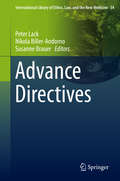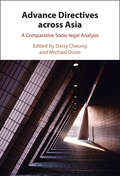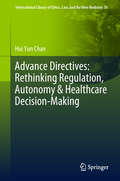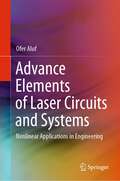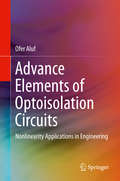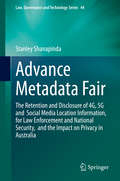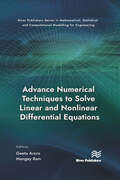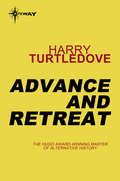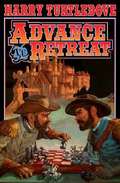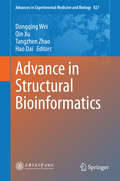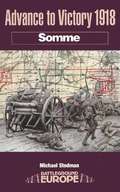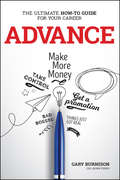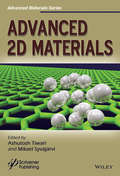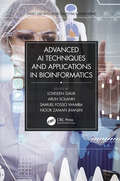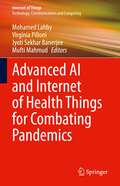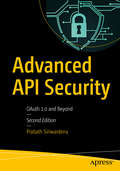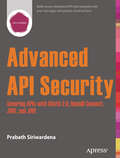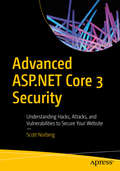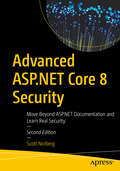- Table View
- List View
Advance Directives (International Library of Ethics, Law, and the New Medicine #54)
by Peter Lack Nikola Biller-Andorno Susanne BrauerThis volume gives an overview on the currently debated ethical issues regarding advance directives from an international perspective. It focuses on a wider understanding of the known and widely accepted concept of patient self-determination for future situations. Although advance directives have been widely discussed since the 1980s, the ethical bases of advance directives still remain a matter of heated debates. The book aims to contribute to these controversial debates by integrating fundamental ethical issues on advance directives with practical matters of their implementation. Cultural, national and professional differences in how advance directives are understood by health care professions and by patients, as well as in laws and regulations, are pinpointed.
Advance Directives Across Asia: A Comparative Socio-legal Analysis
by Michael Dunn Daisy CheungThis book is the first to consider comprehensively and systematically the law and practice of advance directives across Asia. It will thus be important not only as a reference volume that documents how advance directives are regulated and used throughout Asia, but also as an exploration of the concept of the advance directive itself, in context. By examining how advance directives operate in Asian countries, we will also shed light on the principle of personal autonomy in this context, alongside other values and religious and socio-cultural factors that shape health and care decision-making. As such, this book will have broad appeal not only to Asian scholars, students, policymakers and practitioners in the fields of health law and ethics and end-of-life care more generally, but will also be of wider interest to an international academic audience in the fields of law, ethics and health and social care research. This title is also available as open access on Cambridge Core.
Advance Directives: Rethinking Regulation, Autonomy & Healthcare Decision-Making (International Library Of Ethics, Law, And The New Medicine Ser. #76)
by Hui Yun ChanThis book offers a new perspective on advance directives through a combined legal, ethical and philosophical inquiry. In addition to making a significant and novel theoretical contribution to the field, the book has an interdisciplinary and international appeal. The book will help academics, healthcare professionals, legal practitioners and the educated reader to understand the challenges of creating and implementing advance directives, anticipate clinical realities, and preparing advance directives that reflect a higher degree of assurance in terms of implementation.
Advance Elements of Laser Circuits and Systems: Nonlinear Applications in Engineering
by Ofer AlufThis book on Advance Elements of Laser circuits and systems Nonlinearity applications in engineering addresses two separate engineering and scientific areas, and presents advanced analysis methods for Laser circuits and systems that cover a broad range of engineering and scientific applications. The book analyzed Laser circuits and systems as linear and nonlinear dynamical systems and there limit cycles, bifurcation, and limit cycle stability by using nonlinear dynamic theory. Further, it discussed a broad range of bifurcations related to Laser systems and circuits, starting from laser system differential equations and their bifurcations, delay differential equations (DDEs) are a function of time delays, delay dependent parameters, followed by phase plane analysis, limit cycles and their bifurcations, chaos, iterated maps, period doubling. It combines graphical information with analytical analysis to effectively study the local stability of Laser systems models involving delay dependent parameters. Specifically, the stability of a given steady state is determined by the graphs of some functions of which can be expressed explicitly. The Laser circuits and systems are Laser diode circuits, MRI system Laser diode circuitry, Electron-photon exchanges into VCSEL, Ti: Sapphire laser systems, Ion channel and long-wavelength lasers, Solid state lasers, Solid state laser controlled by semiconductor devices, microchip solid-state laser, Q-switched diode-pumped solid-state laser, Nd:YAG, Mid-Infrared and Q-switched microchip lasers, Gas laser systems, copper vapor laser (CVL) circuitry, Dual-wavelength laser systems, Dual-wavelength operation of a Ti:sapphire laser, Diode-pumped Q-switched Nd:YVO4 yellow laser, Asymmetric dual quantum well lasers, Tm3+-doped silica fibre lasers, Terahertz dual-wavelength quantum cascade laser. The Book address also the additional areas, Laser X guiding system, Plasma diagnostics, Laser Beam shaping, Jitter and crosstalk, Plasma mirror systems, and High power Laser/Target diagnostic system optical elements. The book is unique in its emphasis on practical and innovative engineering and scientific applications. All conceptual Laser circuits are innovative and can be broadly implemented in many engineering applications. The dynamics of Laser circuits and systems provides several ways to use them in a variety of applications covering wide areas. This book is aimed at electrical and electronics engineers, students and researchers in physics as well. It is also aimed for research institutes in lasers and plasma physics and gives good comprehensive in laser and plasma systems. In each chapter, the concept is developed from basic assumptions up to the final engineering and scientific outcomes. The scientific background is explained at basic and advance levels and closely integrated with mathematical theory. Many examples are presented in this book and it is also ideal for intermediate level courses at graduate level studies. It is also ideal for engineer who has not had formal instruction in nonlinear dynamics, but who now desires to fill the gap between innovative Laser circuits/systems and advance mathematical analysis methods.
Advance Elements of Optoisolation Circuits: Nonlinearity Applications in Engineering
by Ofer AlufThis book on advanced optoisolation circuits for nonlinearity applications in engineering addresses two separate engineering and scientific areas, and presents advanced analysis methods for optoisolation circuits that cover a broad range of engineering applications. The book analyzes optoisolation circuits as linear and nonlinear dynamical systems and their limit cycles, bifurcation, and limit cycle stability by using Floquet theory. Further, it discusses a broad range of bifurcations related to optoisolation systems: cusp-catastrophe, Bautin bifurcation, Andronov-Hopf bifurcation, Bogdanov-Takens (BT) bifurcation, fold Hopf bifurcation, Hopf-Hopf bifurcation, Torus bifurcation (Neimark-Sacker bifurcation), and Saddle-loop or Homoclinic bifurcation. Floquet theory helps as to analyze advance optoisolation systems. Floquet theory is the study of the stability of linear periodic systems in continuous time. Another way to describe Floquet theory, it is the study of linear systems of differential equations with periodic coefficients. The optoisolation system displays a rich variety of dynamical behaviors including simple oscillations, quasi-periodicity, bi-stability between periodic states, complex periodic oscillations (including the mixed-mode type), and chaos. The route to chaos in this optoisolation system involves a torus attractor which becomes destabilized and breaks up into a fractal object, a strange attractor. The book is unique in its emphasis on practical and innovative engineering applications. These include optocouplers in a variety of topological structures, passive components, conservative elements, dissipative elements, active devices, etc. In each chapter, the concept is developed from the basic assumptions up to the final engineering outcomes. The scientific background is explained at basic and advanced levels and closely integrated with mathematical theory. The book is primarily intended for newcomers to linear and nonlinear dynamics and advanced optoisolation circuits, as well as electrical and electronic engineers, students and researchers in physics who read the first book "Optoisolation Circuits Nonlinearity Applications in Engineering". It is ideally suited for engineers who have had no formal instruction in nonlinear dynamics, but who now desire to bridge the gap between innovative optoisolation circuits and advanced mathematical analysis methods.
Advance Metadata Fair: The Retention and Disclosure of 4G, 5G and Social Media Location Information, for Law Enforcement and National Security, and the Impact on Privacy in Australia (Law, Governance and Technology Series #44)
by Stanley ShanapindaThis book outlines the legal powers of a major Western nation – Australia – to collect and use location information. Mobile service and social media service providers now have the ability to track, record and store more precise location information. Unlike 4G, 5G mobile communications require that cell towers and antennas be in much closer proximity; as a result, the location data can reveal more personal and sensitive information about individual citizens. Despite this aspect, service providers are required to disclose the data to the authorities, without the need for a judicial warrant. This book was written from the perspective of big location data software analytics, a capability that makes it possible to combine various location data points to create a profile on a given individual’s movements, habits, and political, religious and ideological orientation. In this regard, privacy is poorly protected. The rationale used to justify the powers was enforcing serious crimes – terrorism offences. Location data can now be retained for at least two years and be collected to investigate even minor offences. This can be done without the person being reasonably suspected of a criminal offence – when the individual is simply determined to be a person of interest. This poses legal risks to vulnerable communities. And yet, such investigative techniques are deemed lawful and reasonable. At a time when national security is so broadly defined to include economic issues, which in turn overlap with climate change and environmental protection, these legal powers should be reassessed. The book clarifies the complex rules that every citizen must know in order to have agency. Further, it calls upon authorities to reflect and to self-regulate, by making the conscious decision to surrender some of their powers to review by the independent judiciary. Without the requirement for a judicial warrant or judicial review, the powers are unfairly broad. The book pursues an interdisciplinary approach to assess the functionality of mobile telecommunications in direct relation to law enforcement powers and existing judicial precedents. Further, it offers a unifying techno-legal perspective on a complex issue touching on modern privacy law and communications technologies.
Advance Numerical Techniques to Solve Linear and Nonlinear Differential Equations (River Publishers Series in Mathematical, Statistical and Computational Modelling for Engineering)
by Mangey Ram Geeta AroraReal-world issues can be translated into the language and concepts of mathematics with the use of mathematical models. Models guided by differential equations with intuitive solutions can be used throughout engineering and the sciences. Almost any changing system may be described by a set of differential equations. They may be found just about anywhere you look in fields including physics, engineering, economics, sociology, biology, business, healthcare, etc. The nature of these equations has been investigated by several mathematicians over the course of hundreds of years and, consequently, numerous effective methods for solving them have been created. It is often impractical to find a purely analytical solution to a system described by a differential equation because either the system itself is too complex or the system being described is too vast. Numerical approaches and computer simulations are especially helpful in such systems. The content provided in this book involves real-world examples, explores research challenges in numerical treatment, and demonstrates how to create new numerical methods for resolving problems. Theories and practical applications in the sciences and engineering are also discussed. Students of engineering and applied mathematics, as well as researchers and engineers who use computers to solve problems numerically or oversee those who do, will find this book focusing on advance numerical techniques to solve linear and nonlinear differential equations useful.
Advance Solar Photovoltaic Thermal Energy Technologies: Fundamentals, Principles, Design, Modelling and Applications (Green Energy and Technology)
by Gopal Nath TiwariThis book discusses topics such as solar energy, heat transfer, solar cell and photovoltaic module, greenhouse-integrated semi-transparent photovoltaic thermal (GiSPVT) system for agriculture and aquaculture, GiSPVT solar dryer, and PVT water and air collector for water heating, air heating, biogas heating and swimming pool heating, etc. The book also discusses energy matrices, including EPBT, EPF, and LCCE. It includes pedagogical elements such as exercises, tables, and figures including problems and objective questions at the end of each chapter. Further, it includes the unit conversion from FPS system to SI unit of each parameter, namely length, energy, power, velocity, pressure force, etc., and some standard constants used in examples. Quasi steady state and periodic modeling of PVT technology described in the book is a useful reference for students, researchers, and academicians to design solar energy-based technology.
Advance Tamil class 11 - Tamil Nadu Board - SCERT: சிறப்புத் தமிழ் தமிழ்நாடு அரசு மேல்நிலை முதலாம் ஆண்டு
by Government TamilnaduEducation is not only the way to become wise but it is the foundation of life forever. We have understood that the textbooks in students hands create a way to succeed as well as lead others to follow up with new inventions. The methods and technics used in this book will definitely make the students to feel free and comfortable even while learning tough concepts.
Advance Your Swagger
by Fonzworth Bentley"My manners were the first ingredient that set me apart from my peers," notes the suave and stylish Fonzworth Bentley, Sean "Diddy" Combs's former personal assistant and a celebrity in his own right. Now, in this one-of-a-kind book, Bentley shares his surefire strategies for success. Just how does a guy move from Atlanta to New York City without knowing a soul in the entertainment industry and become, in less than two years, the P. A. to one of the biggest moguls in hip-hop history? Bentley attributes his accomplishment to one key equation: Manners + Confidence + Style = Swagger. With this formula, Bentley transformed himself into an icon of unflappable grace, elegance, and good manners-and now he's on a mission to help you step up your game, advance your swagger, get ahead, and live out your dreams. Inside you'll learn everything you need to know about * manners and the magic of Please and Thank You * the art of eating well, from which glass to use to handling the napkin * the basics of fine dining, whether you're a host or a guest * the do's and "oh no you didn't's" of cell phones, e-mail, and text messaging * projecting confidence through your body language * the power of introductions, even when you can't remember someone's name * what to do before, during, and after a job interview * body maintenance, from hair to toes to pearly whites * the principles of timeless fashion, so you never go out of style * 15 things every man and 15 things every woman must have in his or her closet Plus "Bent Hints"-little things to keep in mind for any occasion. Though we seem to be in the midst of what Bentley calls "the Golden Age of Disrespect," he demonstrates how we can add a touch of class and dignity to our lives. He's here to make sure your color schemes are fly and your stance is stage-ready. Advance Your Swagger is the lifestyle book of the year.He's taken care of his world--now let Mr. Bentley whip yours into style.
Advance and Retreat
by Harry TurtledoveThe North shall rise again!When Avram became King of Detina, he announced his plan to liberate the blond serfs - and immediately plunged the kingdom into a long and bloody civil war, setting brother against brother. The northern provinces, dependent on the labour of their serfs, seceded, choosing Avram's cousin, Grand Duke Geoffrey, as their king. To save the kingdom, Avram sent armies clad in grey against the north, battling Geoffrey's army, arrayed in blue.Though King Avram held more land and wealth than Geoffrey, Geoffrey's men were better soldiers and the north had more powerful wizards. Still, as the war raged on, the greater population and the superior organisation of the South began to tell and the tide turned against the north.Even so, the war is far from over. The armies of the sough must now battle the north on its own ground - ground which will prove treacherous and deadly...
Advance and Retreat (The War Between the Provinces #3)
by Harry TurtledoveTHE NORTH SHALL RISE AGAIN! When Avram became King of Detina, he declared he intended to liberate the blond serfs from their ties to the land. This noble assertion immediately plunged the kingdom into a civil war that would prove long and bloody, and set brother against brother. The northern provinces, dependent on their serf's labor, seceded, choosing Avram's cousin, Grand Duke Geoffrey, as their king. To save the kingdom, Avram sent armies clad in gray against the slave-holding North, battling Geoffrey's army, arrayed in blue. Though King Avram held more land and wealth than Geoffrey, Geoffrey's men were better soldiers and the North had better and more powerful wizards. Still, as the war raged on, greater population and superior organization began to tell and the tide turned against the North. Even so, the war is far from over. The South still faces two formidable leaders: General Bell, whose loss of a leg has only strengthened his resolve, and Ned of the Forest, whose unicorn riders are the most dangerous force on the Northern side. And though the Southern sorcerers have become more adept at war spells, use of sorcery is unpredictable --as the North learned earlier when its forces held an almost impregnable position, but retreated in terror when an overconfident sorcerer went North on its own ground, ground which will prove treacherous and deadly. . . .
Advance in Barley Sciences: Proceedings of 11th International Barley Genetics Symposium (Advanced Topics In Science And Technology In China Ser.)
by Chengdao Li Guoping Zhang Xu LiuAdvance in barley sciences presents the latest developments in barley sciences. It collects 39 papers submitted to the 11th International Barley Genetics Symposium, and covers all presentation sessions of the conference, i.e., barley development and economy, utilization of germplasm, genetic resources and genetic stocks, end-uses, biotic stress tolerance, abiotic stresses, new and renewed breeding methodology, barley physiology, breeding success stories, barley genomics and all other '-omics.' Th e information will be useful for barley breeders, brewers, biochemists, molecular geneticists and biotechnologists. Th is book may also serve as reference text for students and scientists engaged in barley research. Dr. Guoping Zhang is a barley breeder and crop physiologist at the Department of Agronomy, Zhejiang University, China. Dr. Chengdao Li is a senior molecular geneticist and barley breeder at the Department of Agriculture and Food, Western Australia, Australia. He is also an adjunct professor at Murdoch University of Australia and Zhejiang University. Dr. Xu Liu, a member of the China Academy of Engineering, is a plant resources researcher at the Chinese Academy of Agricultural Sciences.
Advance in Structural Bioinformatics (Advances in Experimental Medicine and Biology #827)
by Dongqing Wei Qin Xu Tangzhen Zhao Hao DaiThis text examines in detail mathematical and physical modeling, computational methods and systems for obtaining and analyzing biological structures, using pioneering research cases as examples. As such, it emphasizes programming and problem-solving skills. It provides information on structure bioinformatics at various levels, with individual chapters covering introductory to advanced aspects, from fundamental methods and guidelines on acquiring and analyzing genomics and proteomics sequences, the structures of protein, DNA and RNA, to the basics of physical simulations and methods for conformation searches. This book will be of immense value to researchers and students in the fields of bioinformatics, computational biology and chemistry. Dr. Dongqing Wei is a Professor at the Department of Bioinformatics and Biostatistics, College of Life Science and Biotechnology, Shanghai Jiaotong University, Shanghai, China. His research interest is in the general area of structural bioinformatics.
Advance to Barbarism: How the Reversion to Barbarism in Warfare and War-Trials Menaces Our Future [Revised Edition]
by F. J. P. VealeWidely regarded as his most important and influential work, Advance to Barbarism was first published in 1948 (under the pen name “A. Jurist.”), with a revised edition followed in 1953. It was issued in several languages, including Spanish and German.This eloquent work traces the evolution of warfare from primitive savagery to the rise of a “civilized” code of armed conflict that was first threatened in the US civil war, and again in the First World War, and was finally shattered during the Second World War.The ensuing “War Crimes Trials” at Nuremberg and Tokyo, and their more numerous and barbaric imitations in Communist-controlled Eastern Europe, Veale argues, established the perilous principle that “the most serious war crime is to be on the losing side.”Advance to Barbarism earned praise from some of the most astute thinkers of the age.“This is a relentlessly truth speaking book. The truths it speaks are bitter, but of paramount importance if civilization is to survive.”—Max Eastman“I have read the book with deep interest and enthusiasm. It is original in its approach to modern warfare, cogent and convincing… His indictment of modern warfare and post-war trials must stand.”—Norman Thomas“The best general work on the Nuremberg Trials. It not only reveals the illegality, fundamental immorality and hypocrisy of these trials, but also shows how they are bound to make any future world wars (or any important wars) far more brutal and destructive to life and property. A very readable and impressive volume and a major contributor to any rational peace movement.”—Harry Elmer Barnes
Advance to Victory, 1918: Somme (Battleground Europe)
by Michael StedmanThe Battleground series is designed for both the battlefield visitor and the reader at home. For the former, this book is an invaluable guide and each site is described in detail. For everyone there are graphic descriptions of action, often through first-hand accounts, supported by illustrations, diagrams and maps.
Advance to Victory, July to September 1918: July to September 1918 (British Expeditionary Force)
by Andrew RawsonThis is the story of the British Expeditionary Forces part in the opening days of the Advance to Victory. It starts with the contribution to the Battle of Fre-en-Tardenois in July; the counter-offensive which pushed the Germans back to the River Marne.Fourth Armys attack on 8 August was called the Black Day of the German Army, but it was only the beginning of 100 days of campaigning. The narrative follows the advance as it expands across the Somme, the Artois and the Flanders regions. Time and again the British and Empire troops used well-developed combined arms tactics to break through successive lines of defence. By the end of September, all five of the BEFs armies had reached the Hindenburg Line and were poised for the final advance.Each stage of the two month battle is given the same treatment, covering the details of the most talked about side of the campaign; the BEFs side. Over fifty new maps chart the day by day progress of the five armies and together with the narrative, explain the British Armys experience during the opening stages of the Advance to Victory. The men who made a difference are mentioned; those who led the advances, those who stopped the counter-attacks and those who were awarded the Victoria Cross. Discover the beginning of the Advance to Victory and learn how the British Army had mastered the art of attack.
Advance: The Ultimate How-To Guide For Your Career
by Gary BurnisonThe how-to guide for your career In his previous book, Lose the Resume, Land the Job, author Gary Burnison exposed the myths and the ineffective thinking around how to land the job you really want. Now, in Advance, he takes readers through the next stage—advancing in their careers. Advance is extremely timely and topical in today's do-it-yourself career development world. Average job tenure has fallen to about four years on average and often only one or two years for younger professionals. These "career nomads" simply aren't around long enough to access career development from their employers. On the other end of the workplace spectrum, many employees find themselves stuck in one job without a promotion, without any raise to speak of, and with no opportunities to learn and grow. In Advance, Burnison lays out a mosaic of "how-to" advice that applies every day and at every level—the skills and behaviors that help people navigate their careers and stand out among the crowd. He takes on a "Top 20" of career must-haves: managing for the first time, engaging in the "money conversation" with your boss, dealing with difficult bosses (without quitting), coping with coworkers (without losing your mind), making presentations (that don't put people to sleep), mastering digital communication (and avoiding emails that will get you fired), thinking globally (without leaving your office), taking an overseas assignment, meeting senior leaders for the first time (without putting your foot in your mouth), navigating political waters (without sinking your career), reading and fitting in with the culture, and more. • Wisdom on taking your career to the next level • Career development tips • Guidance on being seen and heard • Written by the CEO of one of the world’s largest management consulting firms Whether you’re just starting your career, high up on the ladder, or “stuck” anywhere in between, Advance gives you the know-how to get on a path to where you want to go.
Advanced 2D Materials
by Ashutosh Tiwari Mikael SyväjärviThis book brings together innovative methodologies and strategies adopted in the research and developments of Advanced 2D Materials. Well-known worldwide researchers deliberate subjects on (1) Synthesis, characterizations, modeling and properties, (2) State-of-the-art design and (3) innovative uses of 2D materials including: Two-dimensional layered gallium selenide Synthesis of 2D boron nitride nanosheets The effects of substrates on 2-D crystals Electrical conductivity and reflectivity of models of some 2D materials Graphene derivatives in semicrystalline polymer composites Graphene oxide based multifunctional composites Covalent and non-covalent polymer grafting of graphene oxide Graphene-semiconductor hybrid photocatalysts for solar fuels Graphene based sensors Graphene composites from bench to clinic Photocatalytic ZnO-graphene hybrids Hydroxyapatite-graphene bioceramics in orthopaedic applications
Advanced AI Techniques and Applications in Bioinformatics (Smart and Intelligent Computing in Engineering)
by Loveleen Gaur, Arun Solanki, Samuel Fosso Wamba and Noor Zaman JhanjhiThe advanced AI techniques are essential for resolving various problematic aspects emerging in the field of bioinformatics. This book covers the recent approaches in artificial intelligence and machine learning methods and their applications in Genome and Gene editing, cancer drug discovery classification, and the protein folding algorithms among others. Deep learning, which is widely used in image processing, is also applicable in bioinformatics as one of the most popular artificial intelligence approaches. The wide range of applications discussed in this book are an indispensable resource for computer scientists, engineers, biologists, mathematicians, physicians, and medical informaticists. Features: Focusses on the cross-disciplinary relation between computer science and biology and the role of machine learning methods in resolving complex problems in bioinformatics Provides a comprehensive and balanced blend of topics and applications using various advanced algorithms Presents cutting-edge research methodologies in the area of AI methods when applied to bioinformatics and innovative solutions Discusses the AI/ML techniques, their use, and their potential for use in common and future bioinformatics applications Includes recent achievements in AI and bioinformatics contributed by a global team of researchers
Advanced AI and Internet of Health Things for Combating Pandemics (Internet of Things)
by Mufti Mahmud Mohamed Lahby Jyoti Sekhar Banerjee Virginia PilloniThis book presents the latest research, theoretical methods, and novel applications in the field of Health 5.0. The authors focus on combating COVID-19 or other pandemics through facilitating various technological services. The authors discuss new models, practical solutions, and technological advances related to detecting and analyzing COVID-19 or other pandemic based on machine intelligence models and communication technologies. The aim of the coverage is to help decision-makers, managers, professionals, and researchers design new paradigms considering the unique opportunities associated with computational intelligence and Internet of Medical Things (IoMT). This book emphasizes the need to analyze all the information through studies and research carried out in the field of computational intelligence, communication networks, and presents the best solutions to combat COVID and other pandemics.
Advanced API Security: OAuth 2.0 and Beyond
by Prabath SiriwardenaPrepare for the next wave of challenges in enterprise security. Learn to better protect, monitor, and manage your public and private APIs. Enterprise APIs have become the common way of exposing business functions to the outside world. Exposing functionality is convenient, but of course comes with a risk of exploitation. This book teaches you about TLS Token Binding, User Managed Access (UMA) 2.0, Cross Origin Resource Sharing (CORS), Incremental Authorization, Proof Key for Code Exchange (PKCE), and Token Exchange. Benefit from lessons learned from analyzing multiple attacks that have taken place by exploiting security vulnerabilities in various OAuth 2.0 implementations. Explore root causes, and improve your security practices to mitigate against similar future exploits. Security must be an integral part of any development project. This book shares best practices in designing APIs for rock-solid security. API security has evolved since the first edition of this book, and the growth of standards has been exponential. OAuth 2.0 is the most widely adopted framework that is used as the foundation for standards, and this book shows you how to apply OAuth 2.0 to your own situation in order to secure and protect your enterprise APIs from exploitation and attack. What You Will LearnSecurely design, develop, and deploy enterprise APIsPick security standards and protocols to match business needsMitigate security exploits by understanding the OAuth 2.0 threat landscapeFederate identities to expand business APIs beyond the corporate firewallProtect microservices at the edge by securing their APIsDevelop native mobile applications to access APIs securelyIntegrate applications with SaaS APIs protected with OAuth 2.0Who This Book Is ForEnterprise security architects who are interested in best practices around designing APIs. The book is also for developers who are building enterprise APIs and integrating with internal and external applications.
Advanced API Security: Securing APIs with OAuth 2.0, OpenID Connect, JWS, and JWE
by Prabath SiriwardenaAdvanced API Security is a complete reference to the next wave of challenges in enterprise security--securing public and private APIs. API adoption in both consumer and enterprises has gone beyond predictions. It has become the &‘coolest&’ way of exposing business functionalities to the outside world. Both your public and private APIs, need to be protected, monitored and managed. Security is not an afterthought, but API security has evolved a lot in last five years. The growth of standards, out there, has been exponential. That's where AdvancedAPI Security comes in--to wade through the weeds and help you keep the bad guys away while realizing the internal and external benefits of developing APIs for your services. Our expert author guides you through the maze of options and shares industry leading best practices in designing APIs for rock-solid security. The book will explain, in depth, securing APIs from quite traditional HTTP Basic Authentication to OAuth 2.0 and the standards built around it. Build APIs with rock-solid security today with Advanced API Security.Takes you through the best practices in designing APIs for rock-solid security.Provides an in depth tutorial of most widely adopted security standards for API security.Teaches you how to compare and contrast different security standards/protocols to find out what suits your business needs the best.
Advanced ASP.NET Core 3 Security: Understanding Hacks, Attacks, and Vulnerabilities to Secure Your Website
by Scott NorbergIncorporate security best practices into ASP.NET Core. This book covers security-related features available within the framework, explains where these feature may fall short, and delves into security topics rarely covered elsewhere. Get ready to dive deep into ASP.NET Core 3.1 source code, clarifying how particular features work and addressing how to fix problems. For straightforward use cases, the ASP.NET Core framework does a good job in preventing certain types of attacks from happening. But for some types of attacks, or situations that are not straightforward, there is very little guidance available on how to safely implement solutions. And worse, there is a lot of bad advice online on how to implement functionality, be it encrypting unsafely hard-coded parameters that need to be generated at runtime, or articles which advocate for certain solutions that are vulnerable to obvious injection attacks. Even more concerning is the functions in ASP.NET Core that are not as secure as they should be by default.Advanced ASP.NET Core 3 Security is designed to train developers to avoid these problems. Unlike the vast majority of security books that are targeted to network administrators, system administrators, or managers, this book is targeted specifically to ASP.NET developers. Author Scott Norberg begins by teaching developers how ASP.NET Core works behind the scenes by going directly into the framework's source code. Then he talks about how various attacks are performed using the very tools that penetration testers would use to hack into an application. He shows developers how to prevent these attacks. Finally, he covers the concepts developers need to know to do some testing on their own, without the help of a security professional. What You Will Learn Discern which attacks are easy to prevent, and which are more challenging, in the frameworkDig into ASP.NET Core 3.1 source code to understand how the security services workEstablish a baseline for understanding how to design more secure softwareProperly apply cryptography in software developmentTake a deep dive into web security conceptsValidate input in a way that allows legitimate traffic but blocks malicious traffic Understand parameterized queries and why they are so important to ASP.NET CoreFix issues in a well-implemented solution Know how the new logging system in ASP.NET Core falls short of security needsIncorporate security into your software development process Who This Book Is ForSoftware developers who have experience creating websites in ASP.NET and want to know how to make their websites secure from hackers and security professionals who work with a development team that uses ASP.NET Core. A basic understanding of web technologies such as HTML, JavaScript, and CSS is assumed, as is knowledge of how to create a website, and how to read and write C#. You do not need knowledge of security concepts, even those that are often covered in ASP.NET Core documentation.
Advanced ASP.NET Core 8 Security: Move Beyond ASP.NET Documentation and Learn Real Security
by Scott NorbergMost .NET developers do not incorporate security best practices when creating websites. The problem? Even if you use all of the best practices that the ASP.NET team recommends, you are still falling short in several key areas due to issues within the framework itself. And most developers don’t use all of the best practices that are recommended. If you are interested in truly top-notch security, available sources don’t give you the information you need. Most blogs and other books simply state how to use the configurations within ASP.NET, but do not teach you security as understood by security professionals. Online code samples aren't much help because they are usually written by developers who aren’t incorporating security practices. This book solves those issues by teaching you security first, going over software best practices as understood by security professionals, not developers. Then it teaches you how security is implemented in ASP.NET. With that foundation, it dives into specific security-related functionality and discusses how to improve upon the default functionality with working code samples. And you will learn how security professionals build software security programs so you can continue building software security best practices into your own Secure Software Development Life Cycle (SSDLC). What You’ll Learn Know how both attackers and professional defenders approach web security Establish a baseline of security for understanding how to design more secure software Discern which attacks are easy to prevent, and which are more challenging, in ASP.NET Dig into ASP.NET source code to understand how the security services work Know how the new logging system in ASP.NET falls short of security needs Incorporate security into your software development process Who This Book Is For Software developers who have experience creating websites in ASP.NET and want to know how to make their websites secure from hackers and security professionals who work with a development team that uses ASP.NET. To get the most out of this book, you should already have a basic understanding of web programming and ASP.NET, including creating new projects, creating pages, and using JavaScript. Topics That Are New to This Edition This edition has been updated with the following changes: Best practices and code samples updated to reflect security-related changes in ASP.NET 8 Improved examples, including a fully-functional website incorporating security suggestions Best practices for securely using Large Language Models (LLMs) and AI Expansions and clarifications throughout
